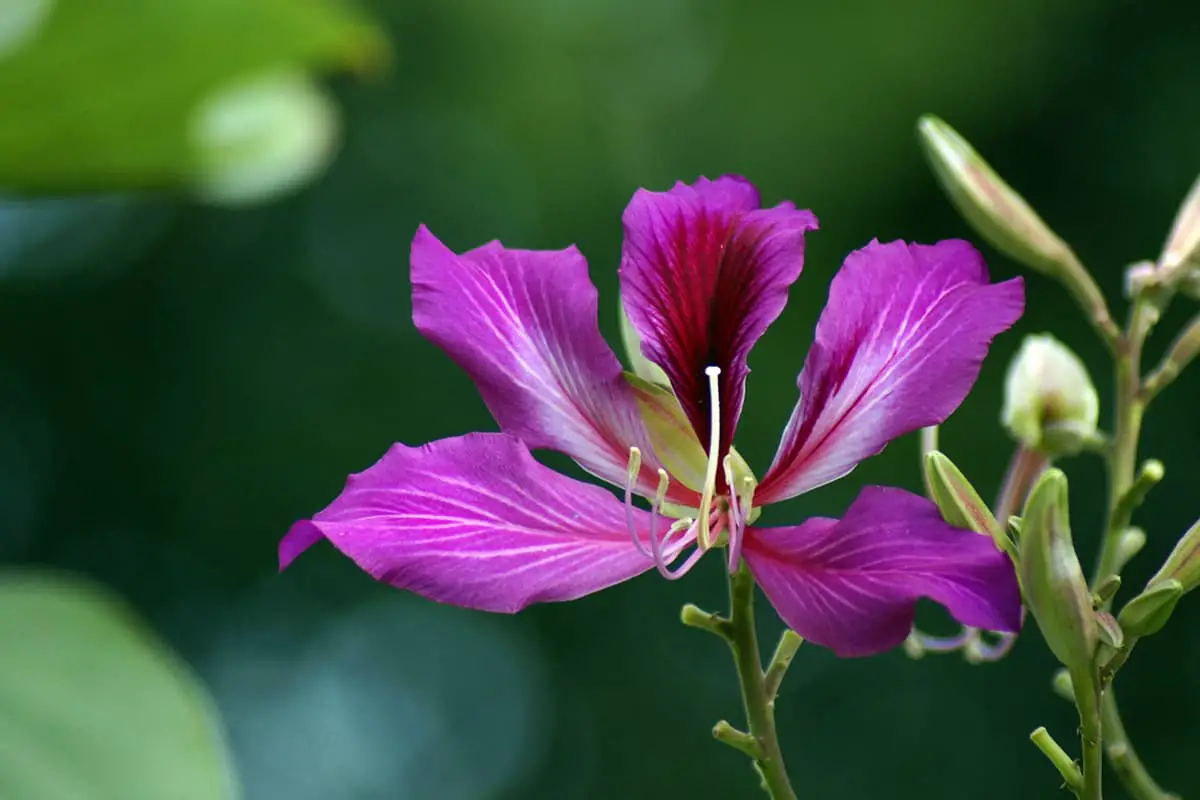
The Bauhinia blakeana, commonly known as the Hong Kong Orchid Tree, is a striking ornamental plant belonging to the Fabaceae (legume) family. This evergreen tree is characterized by its robust branches, glossy, bilobed leaves resembling butterfly wings, and spectacular orchid-like flowers.
The leaves are large, 10-15 cm across, with a distinctive cleft that gives them a unique, twin-lobed appearance. They are deep green, leathery in texture, and have smooth margins. The leaf stalks (petioles) are slender and hairless, allowing the leaves to move gracefully in the breeze.
The inflorescence is a raceme, typically bearing 3-7 flowers. Each flower is large, measuring 10-15 cm in diameter, with five showy petals that range in color from purplish-pink to magenta.
The petals are broadly ovate with ruffled edges and long, slender claws at the base. The flowers have a delicate, sweet fragrance and bloom profusely from late autumn through early spring, with peak flowering occurring from November to March.
One of the most intriguing aspects of Bauhinia blakeana is its sterility. The tree does not produce viable seeds or fruits, which is why it’s primarily propagated through vegetative methods such as stem cuttings, air layering, or grafting. This sterility is attributed to its hybrid nature, believed to be a cross between Bauhinia purpurea and Bauhinia variegata.
Native to Hong Kong, this tree thrives in subtropical to tropical climates. It prefers full sun to partial shade and grows best in well-drained, fertile soils with a pH range of 5.5-8.0. While it can tolerate brief periods of light frost, prolonged exposure to temperatures below 0°C (32°F) can cause damage.
Bauhinia blakeana holds significant cultural importance in Hong Kong, where it was discovered in the late 19th century. It was named after Sir Henry Blake, the Governor of Hong Kong from 1898 to 1903. The tree’s flower was adopted as Hong Kong’s floral emblem in 1965 and features prominently on the region’s flag, coins, and official logo.
In horticulture, Bauhinia blakeana is highly valued for its ornamental qualities. It’s widely used in street plantings, parks, and gardens throughout tropical and subtropical regions worldwide. The tree typically grows to a height of 10-15 meters, with a spread of 6-8 meters, making it suitable for medium-sized landscapes.
While the medicinal uses mentioned in the original text are associated with some Bauhinia species, it’s important to note that B. blakeana itself is not commonly used in traditional medicine due to its rarity and conservation status. The medicinal properties attributed to it may be confused with those of its parent species or other Bauhinia varieties.
In conclusion, Bauhinia blakeana is a horticultural gem, prized for its stunning flowers and cultural significance. Its unique characteristics, including its sterility and hybrid nature, make it an fascinating subject for botanical study and a beloved ornamental tree in many parts of the world.
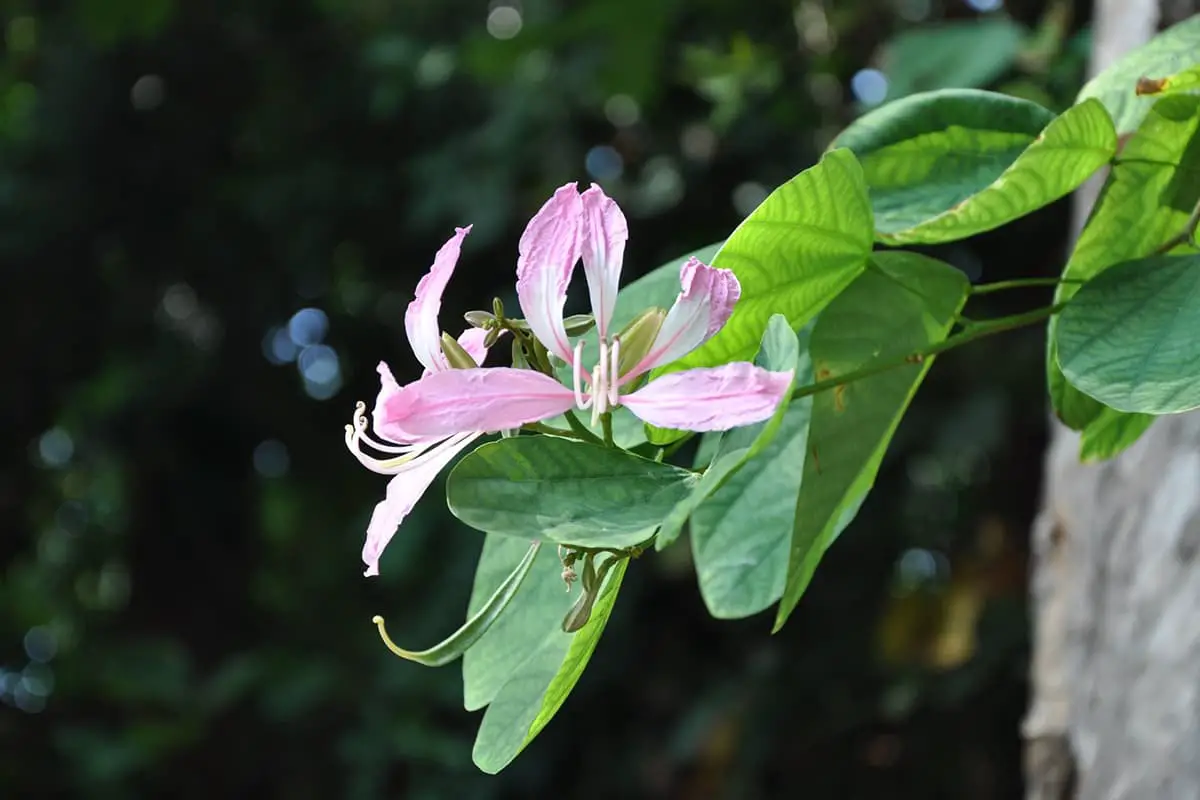
Bauhinia purpurea, commonly known as the Purple Orchid Tree or Butterfly Tree, is a striking member of the Fabaceae (legume) family. This species is a small to medium-sized evergreen tree or large shrub, typically growing to a height of 6-12 meters. Its bark is thick and relatively smooth, ranging in color from light gray to dark brown as the tree matures.
The leaves of B. purpurea are distinctive and easily recognizable. They are bilobed, resembling a cow’s hoof or butterfly wings, which gives rise to one of its common names. These leaves are broadly ovate to nearly circular, measuring 10-15 cm across, with a papery texture and a slightly glossy surface.
The flowers are the most spectacular feature of this tree, blooming profusely from September to November. They are large (8-12 cm across), fragrant, and orchid-like in appearance, with five petals.
The color ranges from vibrant purple-red to light pink, creating a stunning display when in full bloom. These showy flowers are not only ornamental but also attract various pollinators, including butterflies and bees.
Following flowering, the fruit develops from February to March. The fruit is a pod characteristic of the legume family, measuring 15-30 cm long. It is strap-shaped, flat, and slightly curved like a sickle. When mature, these pods split open with a twisting action, forcefully ejecting the seeds in a process known as ballistic dispersal.
The seeds are nearly circular, flat, and dark brown, measuring about 1-1.5 cm in diameter. They are hard-coated and may require scarification for successful germination.
Native to southern Asia, B. purpurea’s natural range includes Hong Kong, the Indochinese Peninsula, and Sri Lanka. It is often found growing on mountains or cliffs at elevations ranging from 400 to 2000 meters above sea level. This adaptability to various altitudes contributes to its wide distribution.
In terms of cultivation, B. purpurea thrives in full sunlight and warm, humid climates. It demonstrates moderate drought tolerance but is sensitive to frost, limiting its cultivation in colder regions. The tree grows rapidly in moist, fertile, well-drained acidic soils with a pH range of 5.5-6.5. While it can adapt to various soil types, it performs best in loamy soils rich in organic matter.
Propagation of B. purpurea is primarily through seeds. Fresh seeds have a high germination rate, but older seeds may require pre-treatment such as soaking in warm water or scarification to break dormancy. Vegetative propagation through cuttings is also possible but less common.
Beyond its ornamental value, B. purpurea has significant medicinal properties rooted in traditional Asian medicine. Various parts of the plant are used for their therapeutic effects:
It’s important to note that while these traditional uses are widespread, scientific research on the efficacy and safety of B. purpurea in treating these conditions is ongoing. As with any medicinal plant, consultation with a healthcare professional is advised before use.
In conclusion, Bauhinia purpurea is a versatile and beautiful tree species that offers both ornamental and potential medicinal value. Its stunning flowers, unique leaf shape, and adaptability to various growing conditions make it a popular choice in tropical and subtropical landscapes, while its traditional medicinal uses continue to be of interest in ethnobotanical studies.

The Begonia x tuberhybrida Voss, commonly known as the Tuberous Begonia, is a striking hybrid perennial from the diverse Begoniaceae family. This ornamental plant typically reaches heights of 20-60 centimeters, characterized by its distinctive irregularly shaped, semi-circular tuber encircled by a network of fine roots.
The plant’s above-ground structure consists of fleshy, multi-branched stems supporting irregularly cordate leaves. These leaves feature a sharp apex, asymmetrical base, and finely serrated margins, contributing to the plant’s ornamental value.
Tuberous Begonias are monoecious, with male and female flowers borne on the same plant. The inflorescence usually comprises three flowers per umbel. The blooms are impressively large, measuring 10-15 cm in diameter, and exhibit a wide spectrum of colors.
Flowers may be single, semi-double, or fully double, with petal edges that can be fimbriate, undulate, or pectinate, adding to their visual appeal. The extended flowering period spans from May through late November, with individual blooms lasting 10-15 days. Post-flowering, the plant produces a three-winged capsule fruit.
Native to the Andean regions of South America, including countries like Peru and Bolivia, Tuberous Begonias naturally occur in montane habitats up to 3000 meters in elevation. This origin influences their cultural requirements in cultivation.
These begonias thrive in warm, humid environments with dappled shade, mimicking their natural understory habitat. Optimal growth occurs in temperatures ranging from 16-21°C (60-70°F). They prefer a well-draining, humus-rich substrate with a slightly acidic pH, typically between 5.5-6.5.
The versatility of Tuberous Begonias makes them popular in various horticultural applications. As potted specimens, they bring vibrant color and charm to interior spaces such as living rooms and window displays.
In outdoor settings, they excel in partially shaded flower beds, mixed borders, and as focal points in landscape designs. Their pendulous growth habit also makes them ideal for hanging baskets, where they can create cascades of color in hallways, balconies, or covered patios.
To maintain their lush appearance and prolific blooming, regular care is essential. This includes consistent moisture (avoiding waterlogged conditions), high humidity, and protection from direct sunlight and strong winds. A balanced, low-nitrogen fertilizer applied during the growing season promotes robust growth and abundant flowering.
With proper care and overwintering of tubers in frost-free conditions, Tuberous Begonias can provide years of spectacular floral displays, making them a cherished addition to both novice and experienced gardeners’ collections.
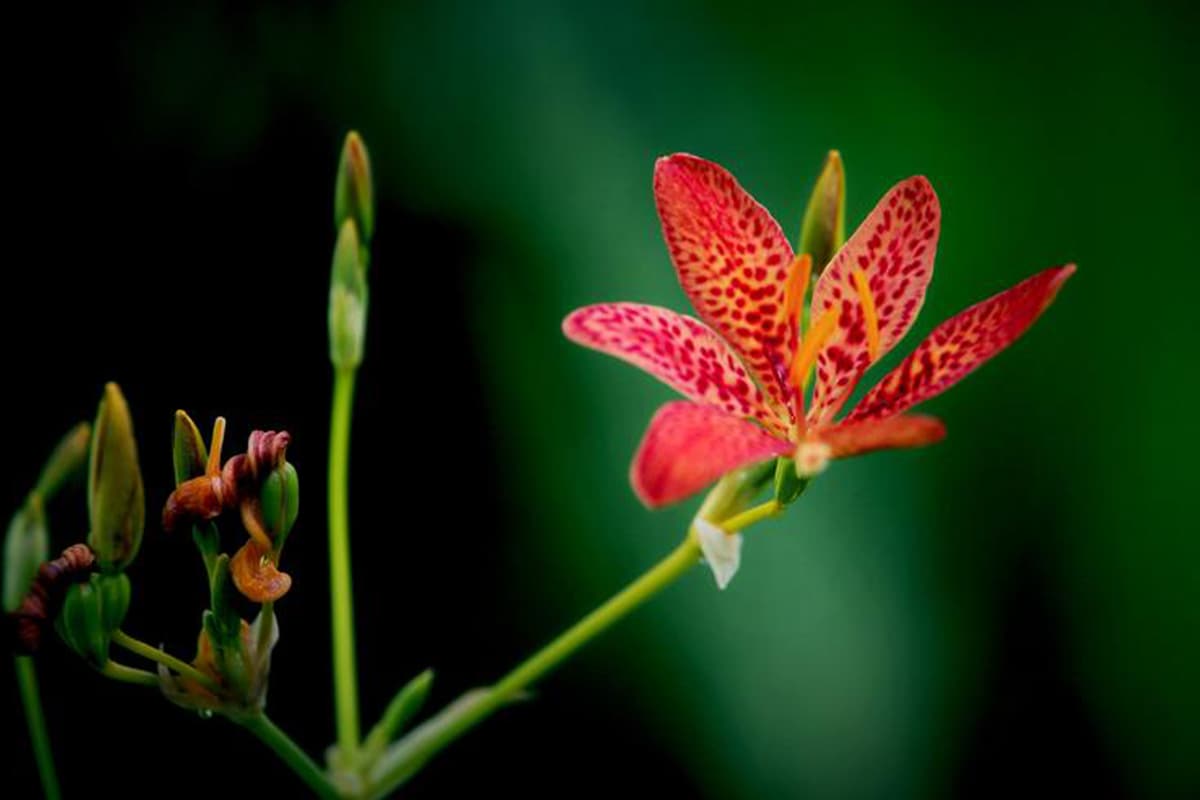
Belamcanda chinensis, commonly known as Blackberry Lily or Leopard Lily, is a striking perennial herb belonging to the Iridaceae family. This ornamental plant boasts a rich history in traditional Chinese medicine and horticulture.
Morphology:
The plant features irregularly shaped, slanting rhizomes that are yellow to yellow-brown in color. Its sword-like leaves emerge in a fan-shaped arrangement, reminiscent of its iris relatives. The most captivating aspect of B. chinensis is its vibrant flowers, which are typically orange to orange-red, adorned with distinctive purple-brown spots, giving rise to its ‘leopard’ moniker.
The flowers, measuring 4-5 cm in diameter, have six tepals and are hermaphroditic. The anthers are linear, while the inferior ovary is ovoid. Post-flowering, the plant produces oval to elongated elliptical capsules. When ripe, these capsules split open to reveal clusters of glossy, spherical seeds that are black-purple in color, resembling blackberries – hence the common name ‘Blackberry Lily’.
Flowering and Fruiting:
Belamcanda chinensis typically flowers from June to August, with fruit formation occurring from July to September. This timing may vary slightly depending on local climate conditions.
Distribution and Habitat:
Native to East Asia, B. chinensis is widely distributed across China and can also be found in neighboring countries including North Korea, Japan, India, and Vietnam. It has also been introduced and naturalized in parts of North America and Europe.
Cultivation Requirements:
This adaptable plant thrives in warm, sunny locations and demonstrates impressive drought and cold tolerance. While it can grow in various soil types, it performs best in well-drained, fertile, loose sandy loam soils. B. chinensis prefers slightly elevated positions and can tolerate neutral to slightly alkaline soils. However, it does not fare well in waterlogged conditions or saline-alkaline soils.
Propagation:
Blackberry Lily can be propagated through both seeds and rhizome division. Seed propagation is often preferred for larger quantities, while rhizome division allows for the preservation of specific cultivar characteristics.
Medicinal Properties:
In traditional Chinese medicine, Belamcanda chinensis, known as “She Gan,” has been used for centuries. Its rhizomes are believed to possess properties that clear heat, detoxify the body, reduce phlegm, and soothe the throat. It has been traditionally used to treat conditions such as tonsillitis, pharyngitis, and certain types of back pain. However, it’s important to note that any medicinal use should be under the guidance of a qualified practitioner.
Cultural Significance:
Beyond its medicinal applications, B. chinensis holds symbolic meaning in some cultures. In the language of flowers, it is often associated with honesty and the joy or happiness of believers, making it a thoughtful addition to symbolic garden designs or floral arrangements.
Horticultural Use:
Belamcanda chinensis is valued in ornamental horticulture for its attractive foliage, unique flowers, and interesting seed pods. It can be effectively used in perennial borders, rock gardens, or as a specimen plant in Asian-inspired garden designs. Its ability to tolerate various growing conditions makes it a versatile choice for many garden settings.
In conclusion, Belamcanda chinensis is a fascinating plant that combines ornamental appeal with historical significance and potential medicinal properties. Its ease of cultivation and striking appearance make it a worthy addition to diverse garden environments, while its rich cultural heritage adds depth to its horticultural value.

The Daisy, scientifically known as Bellis perennis, is a perennial herbaceous plant belonging to the Asteraceae family. This diminutive plant typically reaches a height of 10-20 cm, featuring basal rosettes of spoon-shaped leaves with rounded tips. The leaf margins are characterized by sparse, blunt or wavy teeth, primarily on the upper half.
The flower heads of Bellis perennis are composite, consisting of a central disk of numerous yellow tubular florets surrounded by a single row of white or pink ray florets. These flower heads are either hemispherical or broad bell-shaped, measuring 2-3 cm in diameter.
The achenes (fruits) are flat, ovate, and lack a pappus, but possess fine longitudinal veins. Daisies bloom prolifically from early spring through summer, with the main flowering period extending from March to June in most temperate regions.
The common name “Daisy” is derived from the Old English “dægesege,” meaning “day’s eye,” referring to the flower’s habit of opening at dawn and closing at dusk. This name has no relation to the size of the flower as compared to chrysanthemums, as previously suggested.
Native to Europe and western Asia, Bellis perennis has naturalized in many temperate regions worldwide. It is indeed the national flower of Italy. Daisies thrive in cool, moist conditions and can tolerate light frosts. While they prefer full sun to partial shade, they may wilt in extreme heat. Contrary to the original text, daisies can actually tolerate some shade, especially in hotter climates.
Propagation of Bellis perennis is primarily achieved through seed sowing, but division of established clumps is also an effective method, especially for named cultivars. Both spring and autumn are suitable for planting, with autumn planting often resulting in stronger plants that flower earlier the following spring.
Medicinally, various parts of the daisy have been used in traditional herbal remedies. The leaves have astringent properties and have been employed topically to help staunch minor bleeding and reduce inflammation.
The flower heads contain saponins and other compounds that may contribute to expectorant and mild antitussive effects, potentially aiding in the treatment of coughs with excessive phlegm. However, it’s important to note that these traditional uses should be approached with caution and under professional guidance.
Recent research has shown that extracts from Bellis perennis contain compounds that may inhibit tyrosinase, an enzyme involved in melanin production. This property has led to interest in using daisy extracts in natural skin-whitening cosmetics. However, more studies are needed to fully understand its efficacy and safety in this application.
Beyond its medicinal and cosmetic applications, the daisy is highly valued for its ornamental qualities in gardens and lawns. Its ability to absorb certain volatile organic compounds (VOCs) emitted by some household items contributes to its air-purifying capabilities, though the extent of this benefit in typical home settings may be limited.
In Western culture, the daisy has long symbolized innocence, purity, and loyal love. This symbolism has made it a popular motif in literature and art. William Shakespeare indeed referenced the daisy in “Hamlet,” where Ophelia includes it in her flower garland, symbolizing innocence.
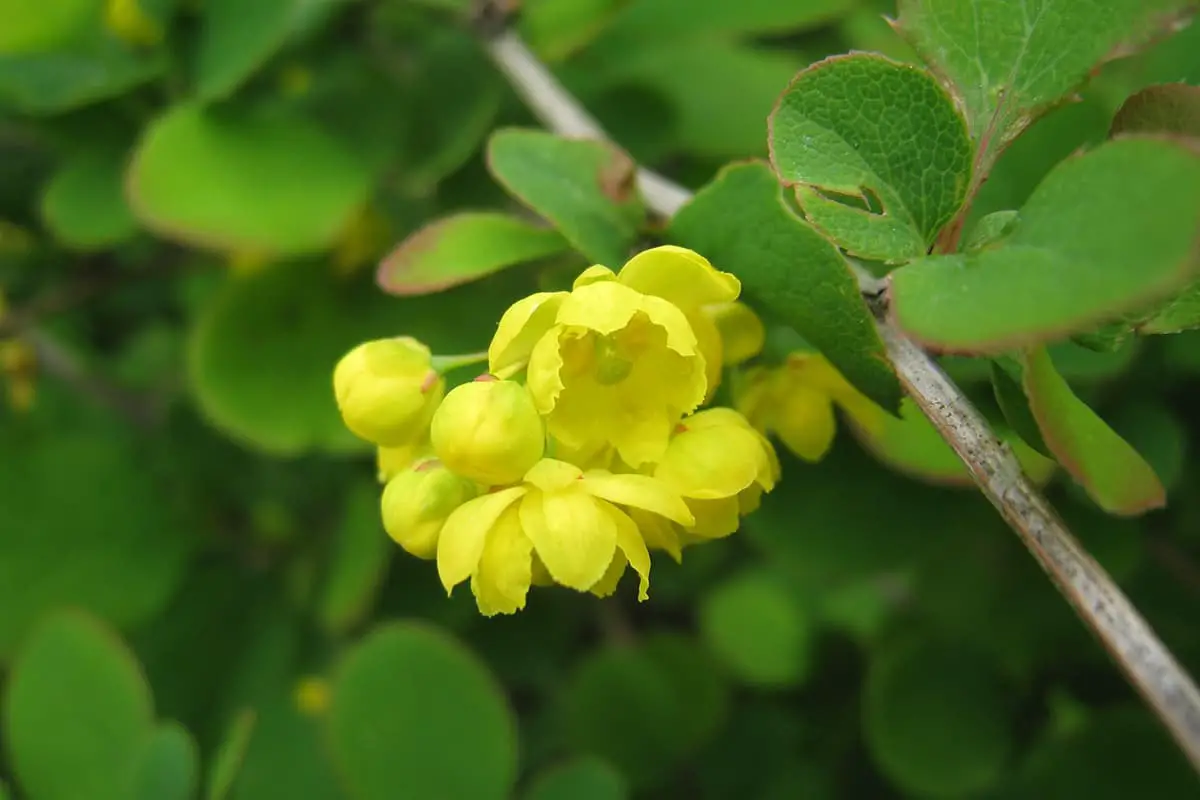
The Japanese Barberry, scientifically known as Berberis thunbergii, is a deciduous shrub belonging to the Berberidaceae family. This species is characterized by its old branches, which are yellow or gray with subtle ridges.
The leaves of B. thunbergii are simple and alternately arranged. They have a papery texture and are typically ovate-elliptic to elliptic in shape. The leaf venation is inconspicuous, and the undersides are light green without any glossy appearance. This foliage often displays vibrant autumn colors, ranging from yellow to red.
The inflorescence of the Japanese Barberry is a glabrous raceme. The flowers are small and yellow, with outer sepals that are ovate in shape and elliptical petals. These flowers are not only attractive to pollinators but also contribute to the plant’s ornamental value.
Following flowering, the plant produces elongated berries that ripen to a bright red color. These fruits do not retain the style at their tips, distinguishing them from some other Berberis species. The blooming period typically occurs from April to May, with fruits developing and ripening from August to September.
In its native range, B. thunbergii is found in Japan and parts of eastern Asia. In China, it is primarily distributed in Heilongjiang, Shandong, Henan, Shaanxi, and Gansu provinces. It also occurs naturally in Korea and parts of eastern Russia. In many other regions, including North America and Europe, it has been introduced and is sometimes considered invasive due to its adaptability and prolific seed production.
The Japanese Barberry demonstrates considerable ecological adaptability. While it prefers full sun to partial shade, it can tolerate a range of light conditions. This shrub thrives in cool, moist climates but is also cold-hardy and moderately drought-tolerant. It is adaptable to various soil types but grows best in fertile, well-drained loamy soils. Notably, it does not tolerate waterlogged conditions well.
In its natural habitat, B. thunbergii is often found in shrublands, valleys, forest edges, or growing among rocks at elevations ranging from 1,100 to 2,850 meters. The plant exhibits strong regenerative capabilities, readily sprouting from its base when cut back, which makes it tolerant of pruning and suitable for hedging.
Propagation of the Japanese Barberry is typically achieved through seed sowing or division of established plants. Its vigorous growth and adaptability have contributed to its popularity in landscaping but have also led to concerns about its invasive potential in some regions.
The roots and stems of B. thunbergii have traditional medicinal uses in some cultures. They are considered to have bitter and cooling properties in traditional Chinese medicine, believed to clear heat and dampness, reduce inflammation, and detoxify the body. While these traditional uses are noted, it’s important to consult with healthcare professionals before using any plant for medicinal purposes.
In traditional medicine, preparations from the plant have been used to address various conditions, including acute enteritis, dysentery, jaundice, cirrhosis with ascites, gonorrhea, pneumonia, sore throat, oral ulcers, carbuncles, mastitis, erysipelas, rheumatism, eczema, and burn injuries. However, scientific evidence supporting these uses is limited, and further research is needed to validate these traditional applications.
Beyond its medicinal potential, the Japanese Barberry is highly valued for its ornamental qualities. Its compact growth habit, colorful foliage, spring blossoms, and autumn fruits make it a popular choice for gardens and landscapes. The plant’s dense growth also makes it effective for creating hedges or barriers.
Additionally, the seeds of B. thunbergii can be pressed to extract oil for industrial applications. The plant’s extensive root system and dense growth habit contribute to its ability to help conserve soil and prevent erosion, making it useful in some land management contexts.
In conclusion, Berberis thunbergii is a versatile and adaptable shrub with significant horticultural value. However, its potential for invasiveness in some ecosystems necessitates careful consideration and management in areas outside its native range. As with any plant introduction, it’s crucial to balance its benefits with potential ecological impacts.

Bianliang’s Verdant Splendor is a distinctive chrysanthemum cultivar renowned for its unique green coloration with subtle greenish-white tints. This medium to large-flowered variety exhibits a rich, vibrant hue when it first blooms, gradually softening as the flower matures.
The flower’s structure is complex, featuring an array of petal types. The primary petals are slender and tubular, with many evolving into spoon-tubular or flat spoon-shaped forms. A notable characteristic is the spoon-shaped hook at the tips of the tubular petals, some of which split as the bloom develops. This creates a dynamic and texturally interesting flower head.
The petals display a captivating color gradient, with a deeper green at the base transitioning to a lighter greenish-white or pure white towards the tips. Fine grooves run along the length of the petals, adding to their visual appeal. The overall petal arrangement forms a hook-looped shape, contributing to the flower’s unique appearance.
At full bloom, Bianliang’s Verdant Splendor reaches an impressive diameter of 16-18 centimeters. The center of the fully opened flower exhibits a slight heart shape, adding to its charm and distinguishing it from other chrysanthemum varieties.
The foliage of this cultivar is equally noteworthy. The leaves are medium-sized with a somewhat dark coloration and thin texture. They feature serrated edges and are accompanied by stipules at their base, a characteristic typical of the Chrysanthemum genus. The stem supporting the blooms and foliage is purple-brown in color, relatively slender, and of medium height.
Bianliang’s Verdant Splendor is a mid-season bloomer, typically flowering during the peak of the chrysanthemum season. Its rarity and unique characteristics make it a prized specimen for exhibitions and collections of unusual chrysanthemum varieties.
Cultivation of this cultivar requires attentive care and specialized horticultural techniques. It has a slightly weak growth habit, necessitating meticulous management, particularly regarding its foliage. Growers can cultivate this variety using various methods, including single-stem, triple-stem, multiple-stem, or grafted techniques, depending on the desired presentation and growing conditions.
For optimal results, cultivators should pay close attention to environmental factors such as light, temperature, and humidity. Regular feeding with a balanced fertilizer formulated for chrysanthemums, along with proper watering and pest management, will help ensure the health and vitality of this exceptional variety.
Due to its delicate nature, Bianliang’s Verdant Splendor may be best suited for experienced growers or enthusiasts willing to invest time and effort into its cultivation.
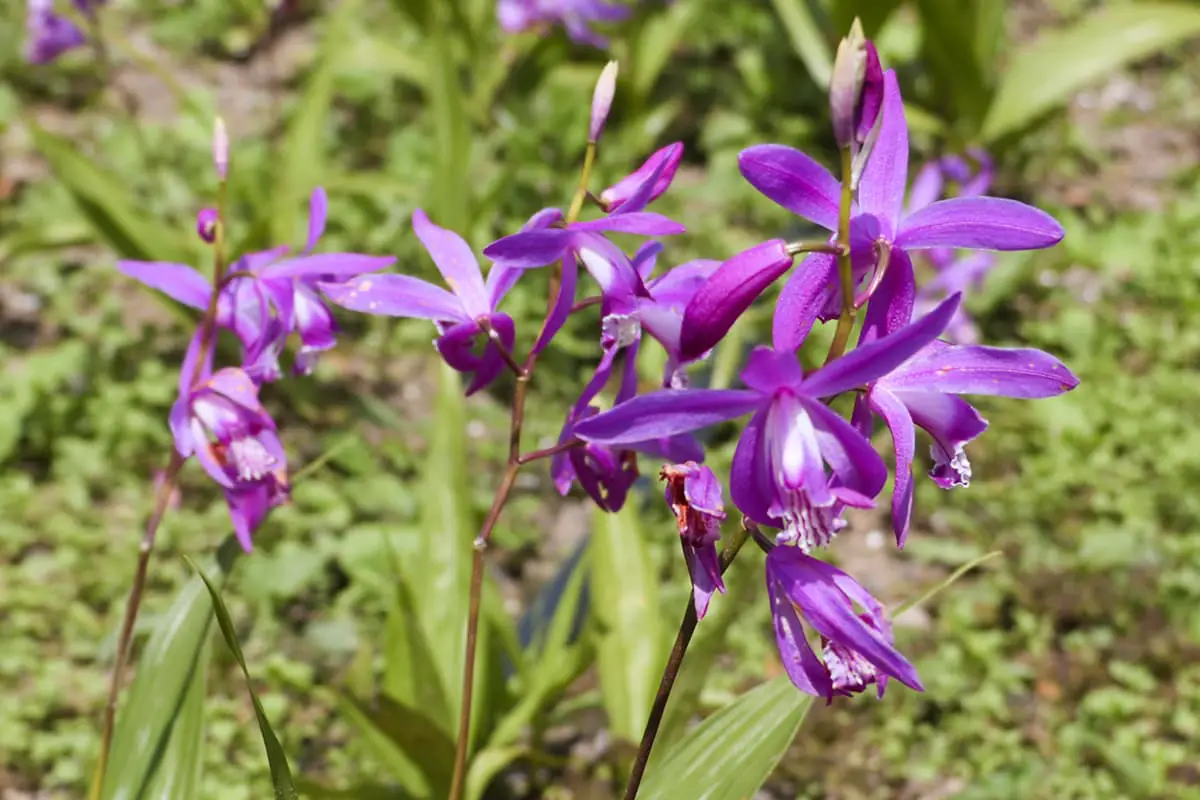
Bletilla striata, commonly known as the Chinese ground orchid or hyacinth orchid, is a resilient terrestrial orchid species belonging to the Orchidaceae family. This elegant perennial herbaceous plant develops pseudobulbs, which are modified underground stems, rather than true bulbs.
The plant typically grows 30-50 cm tall, featuring robust, upright stems. Its leaves are pleated, lanceolate to broadly lanceolate, measuring 15-30 cm long and 2-5 cm wide. The foliage tapers to a point at the tip and has parallel veins running along its length. The leaf margins are entire or slightly undulating.
Flowering occurs from late spring to early summer, generally between April and June. The inflorescence, a terminal raceme, bears 3-8 showy flowers. Each blossom measures about 5 cm across and displays a striking purple-pink to magenta coloration, though white and light pink varieties also exist. The floral bracts are indeed oblong-lanceolate and caducous, falling off as the flowers open.
Bletilla striata is native to East Asia, with its natural range encompassing central and southern China, Japan, Korea, and Taiwan. In its native habitat, it thrives in diverse environments, including deciduous and evergreen broad-leaved forests, grassy slopes, and rocky outcrops. The species adapts well to elevations ranging from near sea level to about 3,200 meters.
This orchid demonstrates remarkable adaptability to various growing conditions. While it prefers partial shade, especially in warmer climates, it can tolerate more sunlight in cooler regions. Bletilla striata favors well-draining, humus-rich soil that remains consistently moist but not waterlogged. It exhibits moderate cold hardiness, typically surviving in USDA zones 5-9 with proper winter protection in colder areas.
The increasing popularity of Bletilla striata in horticulture and traditional medicine has led to overexploitation of wild populations. This has resulted in the depletion of natural resources and subsequent conservation concerns, prompting efforts to promote sustainable cultivation practices.
In traditional Chinese medicine, the pseudobulbs of Bletilla striata, known as “Bai Ji,” are valued for their medicinal properties. The plant has a complex phytochemical profile, containing compounds such as bibenzyls, phenanthrenes, and polysaccharides. These contribute to its reported astringent, hemostatic, anti-inflammatory, and wound-healing properties.
Beyond its medicinal applications, Bletilla striata has found diverse uses across various industries. In cosmetics, extracts from the plant are incorporated into skincare formulations for their moisturizing and anti-aging effects.
The polysaccharides derived from Bletilla striata have applications in the development of biodegradable adhesives and food additives. In horticulture, this orchid is prized for its ornamental value, gracing rock gardens, woodland settings, and mixed perennial borders with its elegant flowers and attractive foliage.
As interest in Bletilla striata continues to grow, research into its cultivation, conservation, and potential applications is ongoing, highlighting the importance of sustainable practices in utilizing this versatile and valuable plant species.
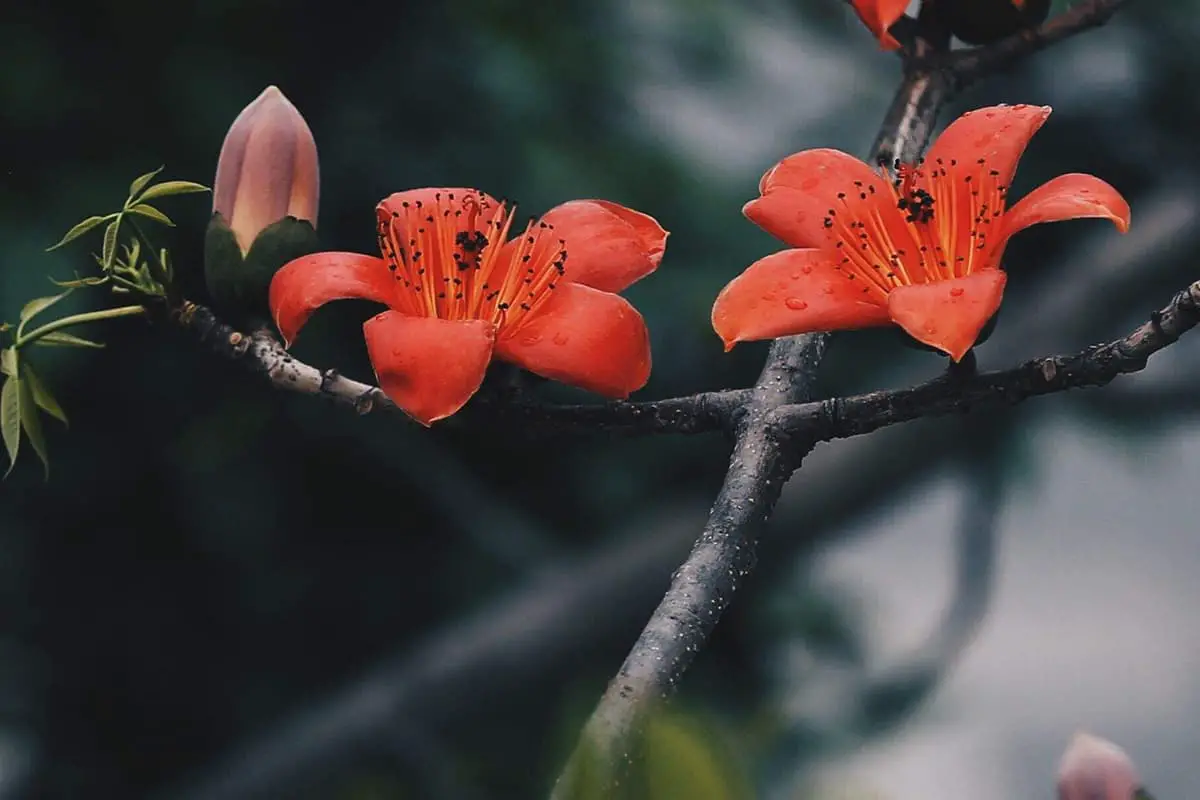
Bombax ceiba, commonly known as the Silk Cotton Tree or Red Silk Cotton, is a magnificent deciduous tree belonging to the Malvaceae family. This impressive species can reach heights of up to 40 meters, with a distinctive ash-grey bark that becomes increasingly fissured with age.
Young specimens of B. ceiba are characterized by conical, thick thorns on their trunks and branches, which serve as a defense mechanism against herbivores. As the tree matures, these thorns gradually disappear. The leaves are palmate, typically comprising 5-7 leaflets, and measure 10-30 cm across.
The flowers of B. ceiba are its most striking feature, emerging before or with the new leaves, depending on the climate. In arid regions, flowering precedes leaf emergence, while in monsoon or rainforest climates, flowers and leaves may appear simultaneously.
The large, showy flowers are usually bright red, though orange-red variants occur. They measure 8-15 cm in diameter and emerge singly from the uppermost leaf axils. Each flower consists of five fleshy petals and numerous prominent stamens, creating a spectacular display that has earned the tree its reputation as a symbol of heroism in many cultures.
Flowering typically occurs between February and April, with regional variations. The fruit, which matures in summer (May to July), is an ellipsoidal capsule 10-15 cm long. It’s densely covered with grayish-white, silky fibers, which give rise to the tree’s common name. When ripe, the capsule splits open to release numerous small, ovoid seeds embedded in this cottony mass.
Native to tropical and subtropical Asia, B. ceiba’s natural range extends from China’s southern provinces through the Indian subcontinent, Southeast Asia, and into northern Australia. It thrives in diverse habitats, including arid river valleys, sparsely wooded grasslands, and monsoon forests, adaptable to altitudes up to 1,500 meters above sea level.
The Silk Cotton Tree holds significant ecological, economic, and cultural value:
Despite its widespread use, the IUCN Red List of Threatened Species classified Bombax ceiba as Least Concern (LC) on September 21, 2018, indicating that it is not currently at risk of extinction. However, conservation efforts are still important to ensure the species’ long-term survival, particularly in areas where habitat loss is a concern.
Borago officinalis, commonly known as borage or starflower, is an annual herb belonging to the Boraginaceae family. This robust plant is characterized by its hirsute appearance, with the entire plant covered in coarse, bristly hairs. It typically reaches a height of 60-100 centimeters, creating a substantial presence in gardens and wild spaces.
The stem of borage is erect, hollow, and cylindrical, providing sturdy support for the plant’s growth. The leaves are arranged alternately along the stem and are ovate in shape, with a rough texture that reflects the plant’s overall bristly nature. This leaf arrangement and texture contribute to the plant’s distinctive appearance and tactile quality.
One of the most striking features of borage is its flowers, which are arranged in a cyme (often mistaken for a corymb). These blossoms are a vivid, deep blue color, although pink and white variations can occasionally occur. The flowers possess a unique, refreshing cucumber-like scent, adding an olfactory dimension to their visual appeal. This scent makes borage flowers a popular addition to summer drinks and salads.
The floral structure of borage is particularly interesting. The corolla consists of five pointed petals fused at the base, forming a star-like shape that gives rise to the plant’s alternative name, starflower.
Borage flowers are perfect, containing both male and female reproductive parts within the same bloom. The five bright yellow stamens form a prominent cone in the center of the flower, contrasting beautifully with the blue petals and adding to the flower’s visual interest.
After pollination, each flower can produce up to four seeds, although not all will always develop. These seeds, technically called nutlets, are black, oblong, and slightly wrinkled, resembling small nuts. The seeds are rich in gamma-linolenic acid (GLA), making them valuable for medicinal and nutritional purposes.
Borage is native to the Mediterranean region, particularly the temperate areas of the Eastern Mediterranean and parts of Western Asia. However, its cultivation has spread widely, and it is now commonly grown throughout Europe and North America. In some regions, it has naturalized and can be found growing wild.
This herb demonstrates remarkable adaptability to various climatic conditions. It is notably cold-hardy, capable of withstanding temperatures as low as -11°C (12°F) without significant damage. Simultaneously, borage exhibits good heat tolerance, thriving in a temperature range of 5-30°C (41-86°F). This adaptability makes it suitable for cultivation in diverse climates.
For optimal growth, borage prefers deep, loose, well-draining soil with high fertility. A sandy loam soil type is ideal, as it provides the right balance of nutrients, moisture retention, and drainage that borage requires. Good drainage is particularly important to prevent root rot, especially in areas with heavy rainfall or during periods of excessive watering.
Borage is celebrated for its versatility as a multifunctional plant. In culinary applications, its young leaves can be used in salads or as a cucumber-flavored garnish, while the flowers are often used to decorate desserts or frozen in ice cubes for summer drinks.
Medicinally, borage has been used traditionally for various purposes, including as an anti-inflammatory and to support adrenal function. The seed oil, rich in GLA, is used in nutritional supplements and skincare products.
Ornamentally, borage is prized in cottage gardens and wildlife-friendly landscapes. Its vibrant blue flowers attract pollinators, particularly bees, making it an excellent addition to any garden aiming to support local ecosystems. In cosmetics, borage oil is valued for its moisturizing and anti-aging properties.
As research continues, the health benefits of borage are becoming increasingly recognized, particularly in relation to its high GLA content, which may offer benefits for skin health, hormonal balance, and inflammatory conditions.
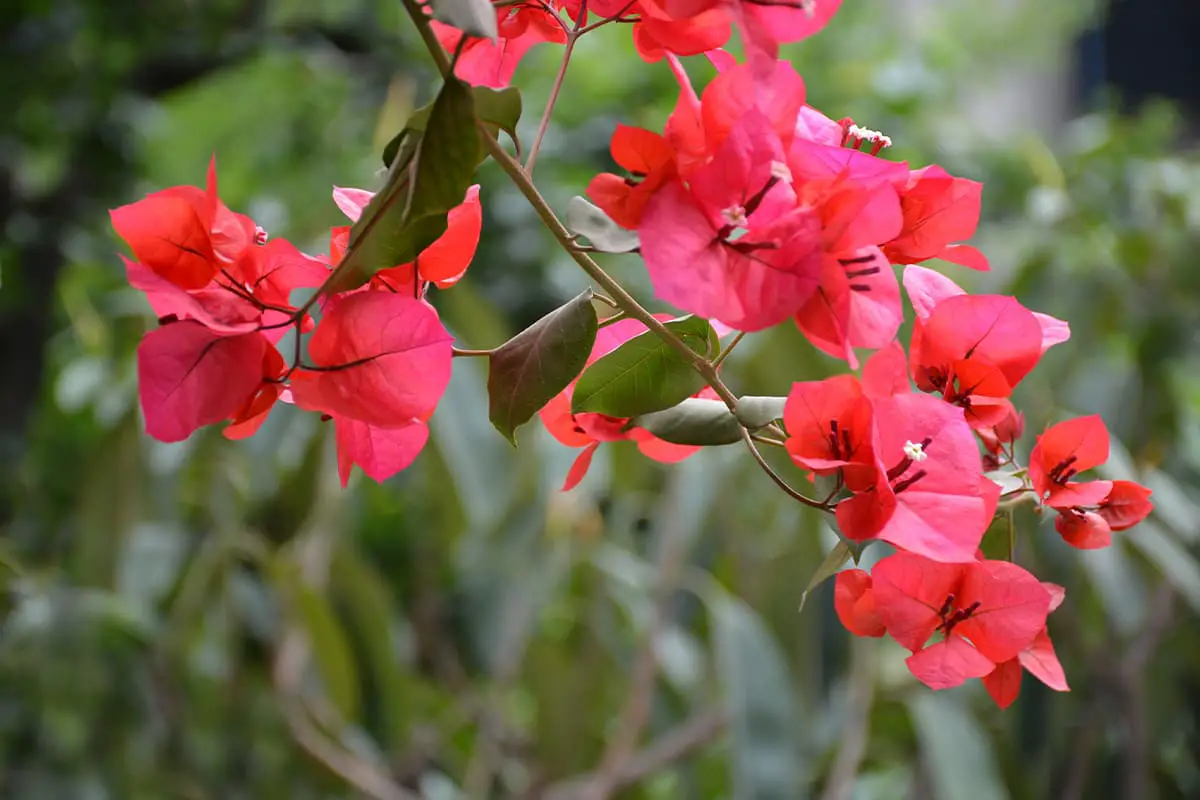
Bougainvillea glabra, commonly known as the Lesser Bougainvillea or Paper Flower, is a vibrant ornamental vine belonging to the Nyctaginaceae family. This woody climber is characterized by its sturdy, arching stems that can grow up to 20-30 feet in length. The branches are typically glabrous (hairless) or sparsely pubescent, contributing to its species name “glabra,” which means smooth.
The leaves of B. glabra are alternately arranged, simple, and ovate to ovate-lanceolate in shape, measuring 5-10 cm long and 2-5 cm wide. They have a papery texture and are dark green in color, providing an attractive backdrop for the plant’s showy floral display.
What are commonly perceived as “flowers” in Bougainvillea are actually modified leaves called bracts. These bracts surround the true flowers, which are small, tubular, and typically white or yellow.
In B. glabra, the bracts are usually vibrant purple or magenta, though cultivars can display a range of colors including pink, red, orange, and white. Each bract cluster typically contains three bracts, which are long-circular or elliptical in shape.
The fruit of B. glabra is a small, dry achene covered in fine, soft hairs. This characteristic aids in seed dispersal by wind or animals.
Native to eastern Brazil, B. glabra has adapted to tropical and subtropical climates worldwide. It typically blooms during winter and spring in its natural habitat. In temperate regions where it’s grown in greenhouses, flowering often occurs between January and March.
The plant’s common name “Paper Flower” refers to the papery texture of its colorful bracts. The genus name Bougainvillea honors Louis Antoine de Bougainville, the French navigator who first observed these plants in Brazil in the 18th century.
B. glabra thrives in warm, humid conditions but is remarkably drought-tolerant once established. It prefers well-draining, fertile soil with a pH range of 5.5-6.5. While it can tolerate poor soils, a loose, organic-rich medium promotes optimal growth. The plant is sensitive to waterlogging and cannot withstand prolonged freezing temperatures.
Propagation of B. glabra is primarily achieved through stem cuttings taken in late spring or early summer. This method ensures genetic consistency and faster establishment compared to seed propagation.
In traditional medicine, various parts of B. glabra have been used for their potential therapeutic properties. The flowers are believed to have blood-regulating and Qi-balancing effects in some traditional Chinese medicine practices. They have also been used to address menstrual irregularities and vaginal discharges, though scientific evidence supporting these uses is limited.
Bougainvillea glabra is highly valued in landscaping for its versatility and striking visual impact. It can be trained as a climbing vine, shaped into a shrub, or used as a colorful groundcover. Its drought tolerance and ability to thrive in poor soils make it an excellent choice for xeriscaping in suitable climates.
In the language of flowers, B. glabra symbolizes passion, perseverance, and tenacity, likely due to its vigorous growth and ability to thrive in challenging conditions. The alternative interpretation of “the sorrow of lacking true love” may stem from cultural associations or literary references, though this symbolism is less commonly recognized in horticultural contexts.
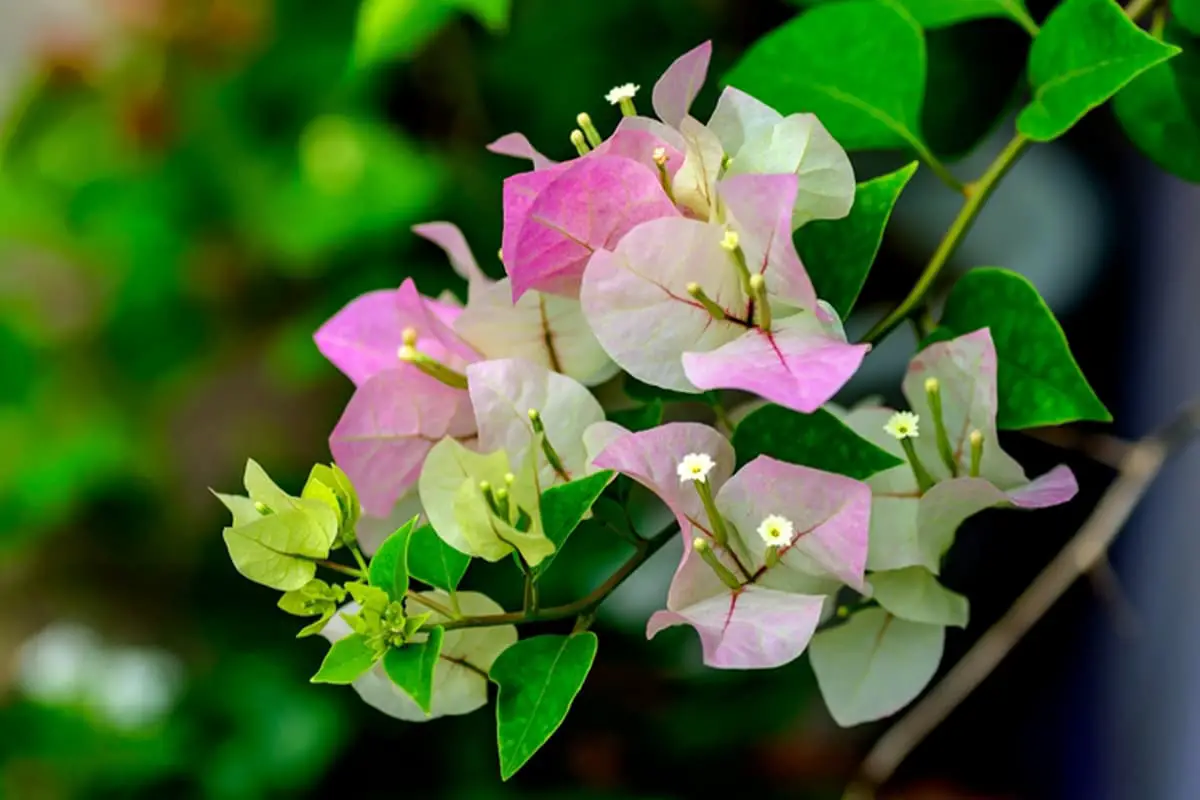
Bougainvillea spectabilis, commonly known as the Great Bougainvillea, is a striking member of the Nyctaginaceae family. This vigorous, vine-like shrub is characterized by its densely pubescent branches and leaves, giving the plant a soft, velvety texture.
The plant’s axils feature distinctive downward-curved thorns, an adaptation that aids in climbing and protection. The leaves are typically elliptical to ovate in shape, with a rounded base, and are arranged alternately along the stems.
One of the most captivating features of B. spectabilis is its floral display. The true flowers are small, tubular, and inconspicuous, typically pale green with yellow lobes. However, what catches the eye are the vibrant, papery bracts surrounding these flowers.
These bracts, often mistaken for petals, are usually ovate or cordate (heart-shaped) at the base and come in rich hues of dark red or light purple-red. The flowers and bracts emerge either from the leaf axils or at the branch tips, creating a spectacular visual effect when in full bloom.
Native to tropical and subtropical regions of South America, the Great Bougainvillea thrives in warm, humid climates with ample sunlight. It demonstrates remarkable adaptability and hardiness, tolerating a range of conditions including brief cold spells and varying soil types. However, for optimal growth and flowering, it prefers well-draining, fertile soil and full sun exposure.
Cultivation of B. spectabilis is relatively straightforward, making it a popular choice for gardeners and landscapers. Propagation is primarily achieved through stem cuttings, which root readily under appropriate conditions. When introducing the plant to new areas, it’s crucial to select a location that receives direct sunlight for most of the day. The plant flourishes in loose, fertile sandy soils that provide good drainage.
Maintenance of the Great Bougainvillea involves regular pruning, especially after flowering periods. This practice not only helps maintain the desired shape but also promotes vigorous growth and abundant flowering in subsequent seasons. While the plant is drought-tolerant once established, consistent moisture during the growing season enhances its performance.
Beyond its ornamental value, B. spectabilis has been recognized for its medicinal properties in traditional medicine systems. The leaves have been used to reduce inflammation, stimulate circulation, and regulate menstruation. However, it’s important to note that the stem contains toxic compounds, and any medicinal use should be under professional guidance.
In the language of flowers, the Great Bougainvillea symbolizes passion, perseverance, and tenacity. These attributes are reflected in its vigorous growth habit and ability to thrive in various conditions. The plant’s vibrant colors and prolific blooming also contribute to its association with passionate emotions.
In conclusion, Bougainvillea spectabilis is a versatile and rewarding plant for both amateur gardeners and experienced horticulturists. Its stunning visual appeal, combined with its adaptability and symbolic significance, makes it a valuable addition to tropical and subtropical landscapes worldwide.
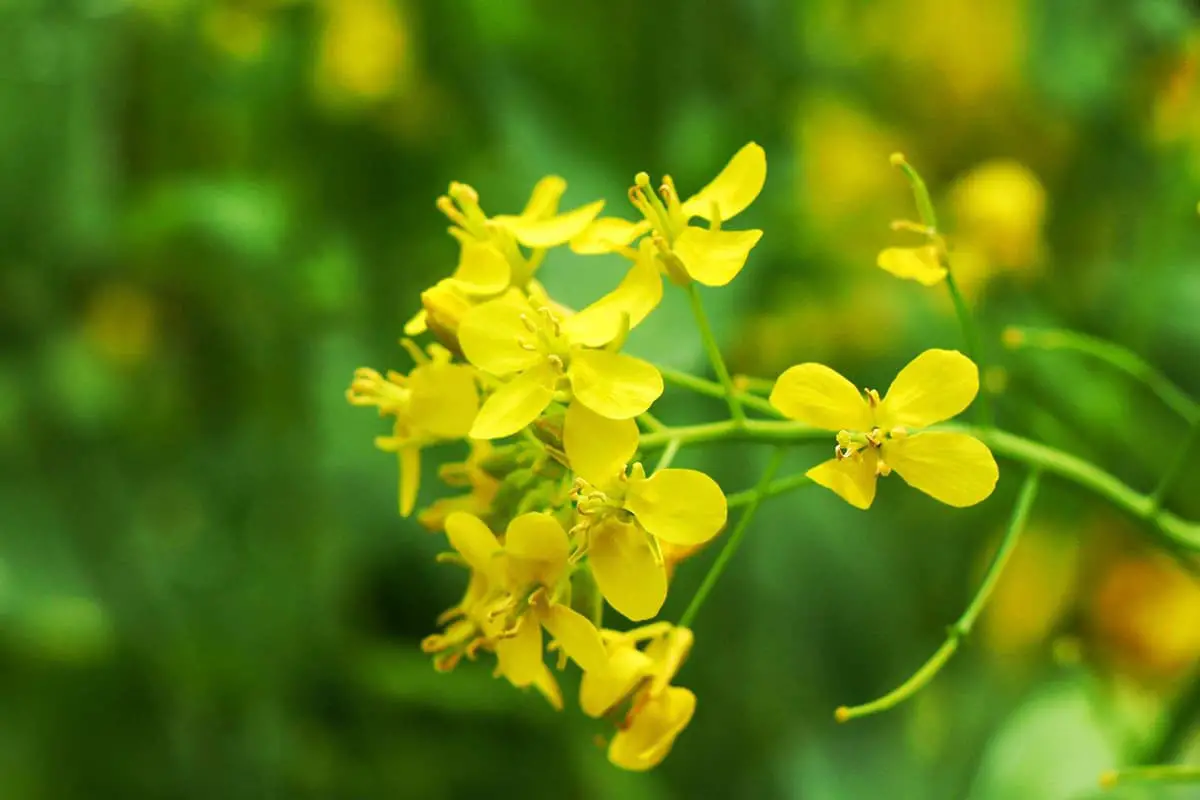
The Rape Blossom, scientifically known as Brassica napus (formerly classified as Brassica campestris), is an important oilseed crop originating from Europe and Central Asia. It is an annual or biennial herbaceous plant belonging to the Brassicaceae family, also known as the cruciferous or mustard family.
The plant exhibits a robust, upright growth habit, typically reaching heights of 30-150 cm. Its stems are smooth, glaucous, and branched, bearing a distinctive blue-green color. The basal leaves form a rosette and are lyrate-pinnatifid, while the upper stem leaves are sessile, entire, and partially clasp the stem with auriculate bases.
The inflorescence is an elongated raceme, bearing bright yellow flowers that are bisexual and actinomorphic (radially symmetrical). Each flower consists of four sepals, four petals arranged in a cross shape (hence the family name “cruciferous”), six stamens (four long and two short), and a superior ovary.
The petals are delicate and silky in texture, resembling fine rice paper, and measure about 1-2 cm in length. The flowering period for Rape Blossom can extend up to 30 days, typically occurring in spring or early summer depending on the variety and growing conditions.
Brassica napus is known for its high pollen production, making it an excellent source of nectar for bees and other pollinators. The seeds contain 35% to 50% oil content, which is rich in monounsaturated and polyunsaturated fatty acids, particularly oleic and linoleic acids. This high oil content makes it valuable for both culinary and industrial purposes.
In addition to oil production, various parts of the plant have diverse uses:
Traditional medicine has long utilized Rape Blossom for its potential health benefits. The juice extracted from the plant is believed to possess properties that may help in:
However, it’s important to note that while these traditional uses exist, scientific research is ongoing to substantiate these claims fully. As with any medicinal use of plants, it’s advisable to consult with healthcare professionals before using Rape Blossom or its derivatives for medicinal purposes.
In agriculture, Brassica napus plays a crucial role in crop rotation systems, helping to break disease cycles and improve soil structure. Its deep taproot system can help alleviate soil compaction and improve drainage. Moreover, as a member of the Brassicaceae family, it exhibits biofumigation properties, potentially suppressing soil-borne pests and diseases.
The cultivation of Rape Blossom continues to evolve with advancements in plant breeding, focusing on developing varieties with improved oil quality, disease resistance, and adaptation to various environmental conditions. This ongoing research ensures that Brassica napus remains a vital crop in global agriculture and food security.
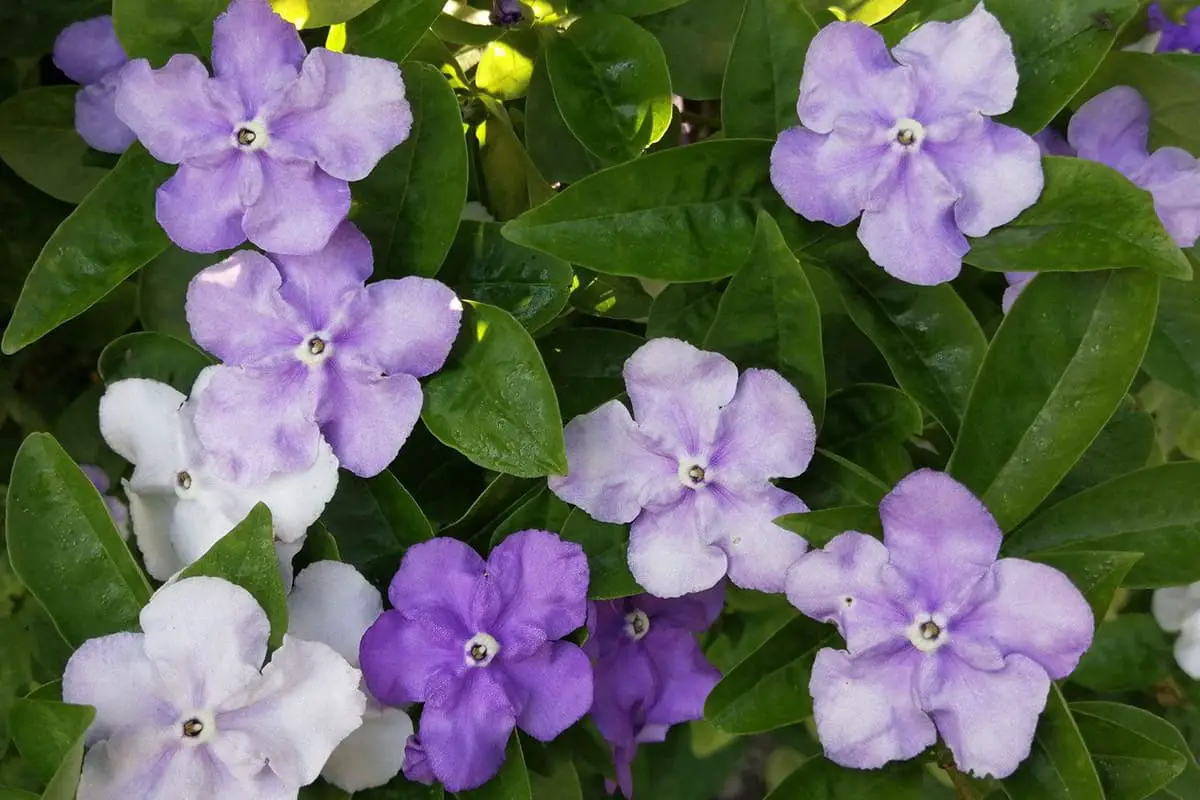
The Yesterday-Today-and-Tomorrow plant, scientifically known as Brunfelsia latifolia (syn. Brunfelsia pauciflora), is an enchanting evergreen shrub belonging to the Solanaceae family. This captivating plant typically grows to a height of 1-3 meters, with some cultivars reaching up to 4 meters in optimal conditions.
The shrub features a woody stem with deep brown bark and exhibits robust branching, creating a dense, rounded form. Its leaves are alternate, simple, and elliptical to obovate in shape, measuring 5-15 cm long. The foliage has a glossy, dark green appearance and a leathery texture, rather than paper-like.
The flowers of Brunfelsia latifolia are its most striking feature, growing in terminal clusters or solitary. Each flower has a tubular calyx and a five-lobed corolla with slightly overlapping petals, rather than serrated. The buds emerge as a deep violet-purple color, resembling small mushrooms. As they open, the flowers emit a sweet, jasmine-like fragrance that intensifies in the evening.
What makes this plant truly remarkable is its color-changing blooms, which inspired its common name. Flowers open as a deep purple, fade to lavender on the second day, and finally turn white on the third day. This progression creates a stunning multi-colored display on a single plant, with all three colors often visible simultaneously.
The primary blooming period for Brunfelsia latifolia is from late spring to early fall (April to October in the Northern Hemisphere), though it may flower sporadically throughout the year in tropical climates.
Native to the tropical and subtropical regions of Brazil, Paraguay, and Argentina, the Yesterday-Today-and-Tomorrow plant thrives in USDA hardiness zones 9-11. It prefers partial shade to full sun exposure, adapting well to various light conditions. While it can tolerate short periods of drought once established, it performs best with regular watering and moderate humidity.
This species is not cold-hardy and can be damaged by temperatures below 5°C (41°F). It requires well-draining, fertile soil that is rich in organic matter and slightly acidic to neutral (pH 6.0-7.0). Good drainage is crucial, as the plant is susceptible to root rot in waterlogged conditions.
Propagation of Brunfelsia latifolia is primarily achieved through semi-hardwood cuttings taken in late summer or early fall. Layering can also be successful, particularly air layering for larger specimens. While seed propagation is possible, it is less common due to the plant’s hybrid nature and the variability of seedlings.
In traditional medicine, particularly in South America, the leaves of Brunfelsia latifolia have been used for their potential anti-inflammatory and analgesic properties. However, it’s important to note that all parts of the plant contain alkaloids that can be toxic if ingested in large quantities, so medicinal use should only be under professional guidance.
The flowers of Brunfelsia latifolia are sometimes used in the fragrance industry due to their sweet, complex scent. In horticulture, this plant is prized for its ornamental value, often used as a specimen shrub, in mixed borders, or as a container plant in cooler climates.
As the national flower of Paraguay, Brunfelsia latifolia holds cultural significance. Its symbolic meaning of “Love Me” in the language of flowers makes it a popular choice for romantic gardens and gift-giving.
In conclusion, the Yesterday-Today-and-Tomorrow plant is a fascinating and beautiful addition to tropical and subtropical gardens, offering a unique color-changing floral display and delightful fragrance. Its care requirements and potential toxicity should be considered when incorporating it into landscape designs or home gardens.
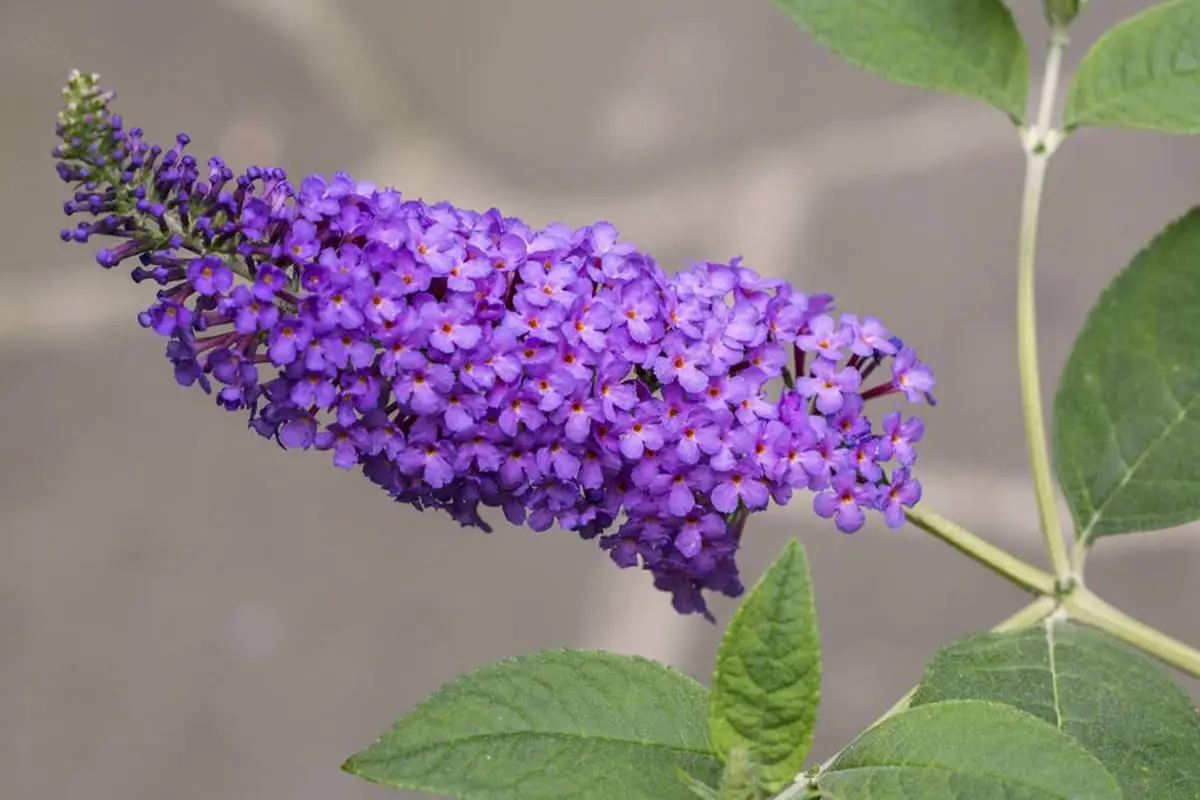
Buddleja lindleyana, commonly known as Lindley’s Butterfly Bush, is a shrub belonging to the Scrophulariaceae family. This species is often confused with Forsythia suspensa, which belongs to a different family (Oleaceae). Buddleja lindleyana has distinctive features that set it apart from other Buddleja species.
The shrub has quadrangular stems with slightly winged ridges, covered in brown bark. Its young twigs are densely covered with stellate short tomentum and glandular hairs, a characteristic feature of many Buddleja species. The leaves are opposite, with petioles also covered in stellate tomentum and glandular hairs.
Leaf blades of Buddleja lindleyana can vary in shape from ovate to elliptical or lanceolate. The flowers are typically purple or lilac, arranged in long, slender panicles. Unlike the statement in the original text, this species does not have a reputation for intoxicating fish when crushed and thrown into water; this property is associated with other plants used in traditional fishing practices.
The flowering period for Buddleja lindleyana extends from late spring to early autumn (April to October), with fruits developing from late summer through the following spring (August to April). The fruit is a capsule, either elongated or oval-shaped, and is glabrous (hairless) but may have scales.
Native to China, Buddleja lindleyana naturally occurs in a variety of habitats including mountain slopes, roadsides, and riversides. It thrives at elevations ranging from 200 to 2700 meters above sea level, often found in shrublands and at forest edges. The species has been widely cultivated and naturalized in various parts of the world, including Malaysia, Japan, the Americas, and Africa.
Buddleja lindleyana prefers full sun to partial shade and well-drained soil. It is known for its resilience, demonstrating strong sprouting capabilities and tolerance to pruning. The plant is adaptable to various environmental conditions, withstanding cold, drought, and poor soil fertility. These characteristics make it a low-maintenance option for gardeners.
Propagation of Buddleja lindleyana can be achieved through seeds, stem cuttings, or division of established plants. Its adaptability and ease of cultivation have contributed to its widespread use in horticulture.
According to the International Union for Conservation of Nature (IUCN) Red List of Threatened Species, Buddleja lindleyana is categorized as Least Concern (LC), indicating that it is not currently at risk of extinction in the wild.
While some Buddleja species have documented medicinal uses, the specific medicinal properties attributed to Buddleja lindleyana in the original text are not well-established in scientific literature. However, like many Buddleja species, it does contain various flavonoids, which may contribute to potential medicinal properties.
Buddleja lindleyana is primarily valued as an ornamental plant. Its fragrant, purple flowers are attractive to butterflies and other pollinators, making it a popular choice for butterfly gardens and parks. While some Buddleja species have been used as natural pesticides, the effectiveness of Buddleja lindleyana specifically for this purpose requires further research.
In conclusion, Buddleja lindleyana is a hardy, attractive shrub with significant ornamental value. Its ability to thrive in various conditions, coupled with its long flowering period, makes it a valuable addition to gardens and landscapes across many regions of the world.
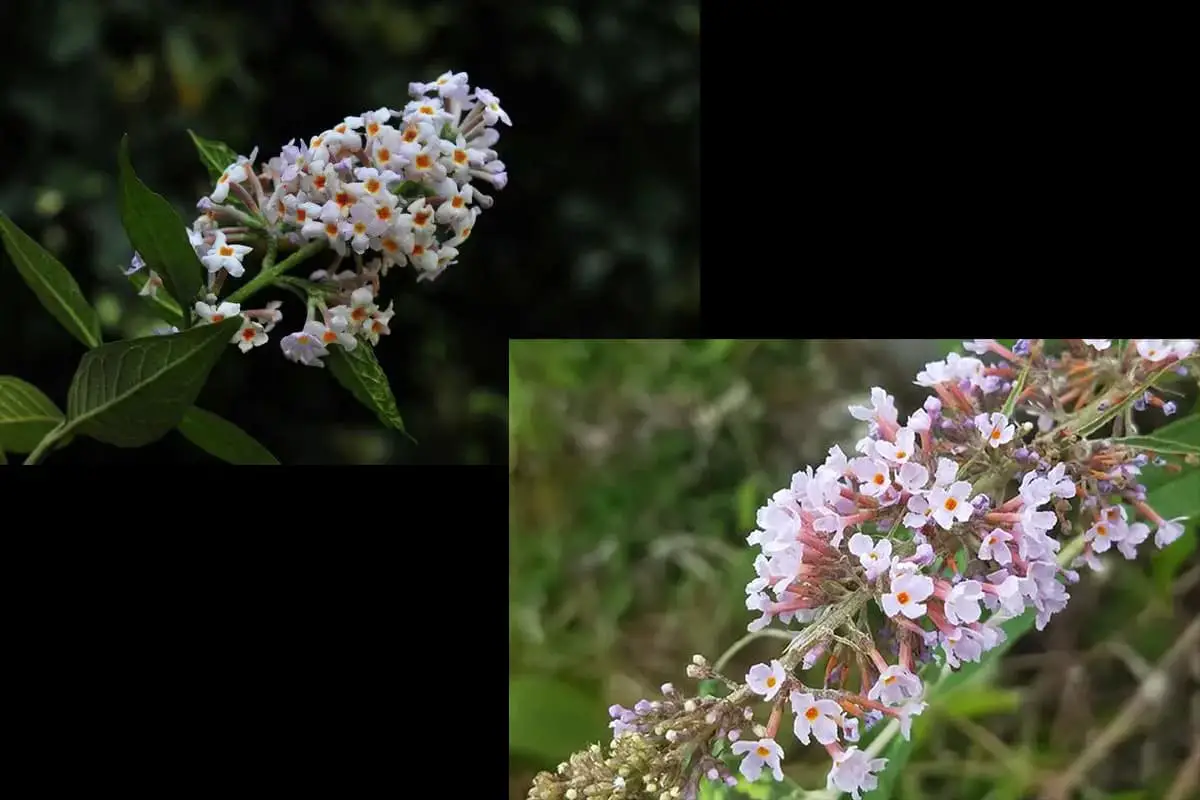
Buddleja officinalis, commonly known as Himalayan butterfly bush or miming flower, is a distinctive member of the Scrophulariaceae family. This deciduous shrub typically grows to a height of 2-4 meters, with its branches densely covered in gray-white stellate trichomes, giving it a soft, velvety texture.
The leaves of B. officinalis are arranged oppositely on the stem and exhibit considerable variation in shape, ranging from narrowly elliptical to ovate or lanceolate. They measure 5-15 cm in length and 1.5-5 cm in width, featuring acuminate tips and cuneate bases.
The leaf margins are often entire but can occasionally be sparsely serrated, especially towards the apex. Both leaf surfaces are adorned with stellate hairs, with the abaxial side being particularly densely pubescent.
The inflorescence is a terminal, conical thyrse, 10-20 cm long, composed of numerous small, fragrant flowers. Each flower has a tubular calyx (3-4 mm long) and a salverform corolla (6-8 mm long) with four lobes. The corolla color varies from white to pale lilac or light purple, often with a contrasting orange throat. Both the calyx and corolla are covered in stellate hairs, contributing to the plant’s overall fuzzy appearance.
Flowering occurs from late winter to early spring (March to April), making B. officinalis an important early-season nectar source for pollinators. The fruits, which develop from May to August, are ovoid capsules (5-7 mm long) covered in stellate hairs. Each capsule contains numerous small, winged seeds, facilitating wind dispersal.
Buddleja officinalis is native to a wide range of habitats across Asia, including various provinces in China (such as Sichuan, Yunnan, and Guizhou), as well as Bhutan, Myanmar, and Vietnam. It shows a preference for sunny, limestone-rich slopes at elevations between 1000-3000 meters. The plant thrives in well-draining, fertile sandy loam soils with a pH range of 6.0-7.5.
Propagation of B. officinalis is primarily achieved through seeds, which should be sown in spring or autumn. The seeds require light for germination, so they should be surface-sown or only lightly covered. Alternatively, semi-hardwood cuttings can be taken in summer for vegetative propagation.
In traditional Chinese medicine, Buddleja officinalis has been used for centuries. The dried flowers (Flos Buddlejae) are the most commonly used part, possessing a sweet flavor and a slightly cold nature according to traditional classifications. They are associated with the liver meridian and are believed to clear heat, promote diuresis, and improve vision. The roots are also utilized for their heat-clearing and detoxifying properties.
Modern phytochemical research has identified several bioactive compounds in B. officinalis, including phenylpropanoid glycosides (such as buddlejoside), flavonoids, and terpenoids. These compounds contribute to its medicinal properties, including anti-inflammatory, antioxidant, and neuroprotective effects.
Beyond its medicinal applications, B. officinalis has several other uses. Its flowers can be used to extract essential oils for perfumery, while the yellow pigments in its flowers serve as natural food colorants. The strong fibers from its stem bark have potential applications in papermaking, although this use is not widely commercialized.
In horticulture, Buddleja officinalis is valued for its early blooming period and fragrant flowers, making it an excellent addition to winter gardens. It is relatively low-maintenance and drought-tolerant once established, but it benefits from regular pruning to maintain its shape and encourage vigorous flowering.
Despite its usefulness and widespread distribution, B. officinalis is categorized as Least Concern (LC) on the IUCN Red List, indicating that it is not currently at risk of extinction. However, as with all wild species, sustainable harvesting practices should be employed to ensure its continued presence in natural ecosystems.